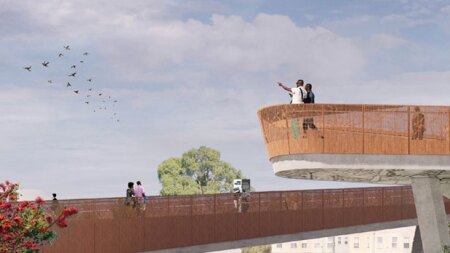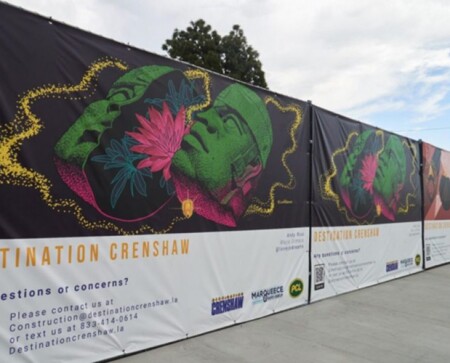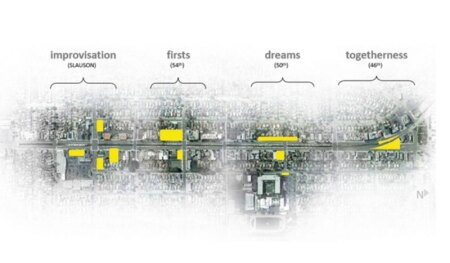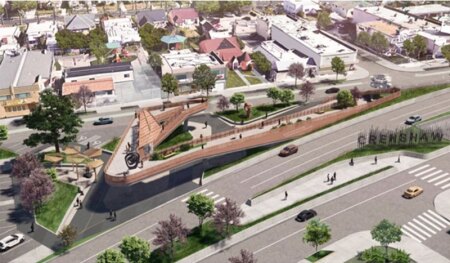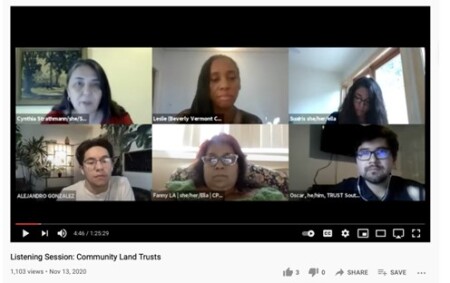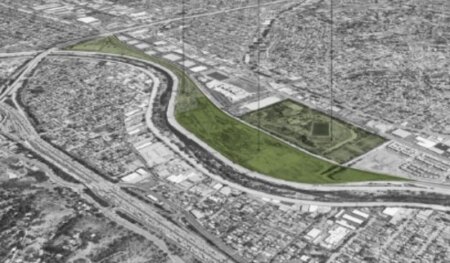Destination Crenshaw, a transformative 1.3-mile (2 km) infrastructure project scheduled to open in fall 2022, was the focus of a ULI-LA virtual event in July—Connection Before Construction: How Destination Crenshaw Will Change Community Engagement—highlighting the latest plans to boost Los Angeles’s Crenshaw community through economic development, job creation, and environmental healing while elevating Black art and culture.
The panel featured Jason Foster, president and chief operating officer of Destination Crenshaw; Drake Dillard AIA, NOMAC, senior project manager and architect with Perkins & Will; and Christopher Hawthorne, chief design office, for the City of Los Angeles Office of Economic Development in a conversation moderated by NPR architecture journalist Frances Anderton.
Foster explained that the project stemmed from the controversial decision to locate the Metro LAX/Crenshaw light rail above ground, bifurcating an essential commercial corridor and neighborhood, while removing hundreds of trees and parking spaces in a black community that was all too familiar with being displaced and disrespected. The project shows that it’s not simply an investment of money, but also investments of time and love that create community where folks want to live, work, play and stay.
The goal of the community outreach was to eliminate what typically makes African American residents fearful of development due to the history of cultural erasure, redlining, and other unfair practices. For example, in 2011 there was a decision to invest $2 billion in grade-level light rail that potentially threatened residents and neighborhoods in one of the largest intact Black communities west of Chicago, including over 40 Black-owned businesses.
Considering the fear Metro expansion created, it was important to emphasize the potential for long-term benefits, according to Foster. Job creation, workforce development, building gathering places, and adding diverse shops and restaurants, all illustrate how Destination Crenshaw will connect the community, instead of dividing or displacing people, as historically occurred.
Destination Crenshaw opens in the fall of 2022 as a place to experience the dynamic expression of Black American culture in Los Angeles, and the United States. The redevelopment targets a 1.3-mile stretch of Crenshaw Boulevard, transforming it from an area sorely lacking in economic investment and strategic urban planning, into a thriving commercial corridor linked by architecturally stunning community spaces and pocket parks, hundreds of newly planted trees, and more than 100 commissioned works of art.
Destination Crenshaw is an outdoor art and cultural experience that includes pocket parks, public art installations featuring more than 100 local artists, and 12 unapologetically Black narratives that tie the Crenshaw community’s history to its future as a neighborhood. Even as construction continues, local art is highlighted on construction barricades through a mini-mural contest to engage and pay local artists to display their work that will create excitement about the future of the Destination Crenshaw project.
According to the panel, the neighborhood conversations addressed the unintended negative effects of public investment focusing on stabilizing a community and providing workforce development in the form of jobs and training. For example, the project contracted 70 percent of its local hire goal with general contractors, PCL Construction, illustrating how development can stabilize and stimulate a community, rather than tear it down.
It was critical to have honest conversations with community members and make sure to listen to the dissenters, Foster said. Developing a sustainable engagement model helps residents stay informed about changes so they better understand the process and continue to have input that will shape future outcomes, as well.
Destination Crenshaw is a 501C-3 that will continue to serve the community after the project is built. Outside of the project, additional services that are currently being addressed include Covid-19 response and assistance to the 43 businesses along the corridor. Ongoing maintenance and operations expenses are developed along with arts, educational, and cultural programming.
Foster believes that the need for continued public and private investment will make Destination Crenshaw a model for impeccable upkeep and community building. He also pointed out one way to ensure future investment and equitable development is through policy measures like tax increment financing or an Enhanced Infrastructure Financing District (EIFD), which will preserve the community and that the development community will play a major role in this, if possible.
Dillard also a Crenshaw District resident, noted that creating a team was the first step in the process. The team included a paid community advisory council, Perkins & Will staff, and the Los Angeles City Council District, including community members, young artists, historians, and landscape architects. Paying the advisory committee and treating them with respect paid off significantly in their overall commitment to the project.
After much discussion the Destination Crenshaw team agreed that North African Giant Star Grass would be the unifying theme for the project as its root system grows both vertically and horizontally and sprouts above ground in different segment. This symbol also serves as an important reminder of the path of African American global migration throughout history and the resilience of Black people in the face of violence and racism. To further expand the experience for people throughout the corridor, the project will be divided into four zones or themes: Improvisation, Firsts, Dreams, and Togetherness:
- Improvisation: Near the Nipsey Hussle store, focuses on arts, entertainment, and creativity.
- Firsts: Honors history by highlighting the ingenuity of the residents, including Paul Williams, Los Angeles’ pioneering Black architect; Tom Bradley, the city’s first Black mayor; and more.
- Dreams: Located next to Crenshaw High School, this zone will highlight education and youth’s dreams about their futures.
- Togetherness: This zone culminates at Leimert Park, where people come together in a beautiful environment to celebrate and have their voices heard as a community.
All of the public art and exhibition components in each node will align with the greater theme and connect the corridor in a continuous message that celebrates the Crenshaw community for residents and visitors alike.
The shade structures and black granite pavement design echoes the North African Star grass and form a root-like unifying backdrop that provides cohesion among each of the four zones and leads residents and visitors down Crenshaw Boulevard past the outdoor gallery and parks, which will consist of more than 800 trees.
As a long-time resident of the area, Dillard was intimately aware of the diverse voices in the community, including affluent and influential Black residents in the Baldwin Hills, Leimert Park, and Crenshaw areas of Los Angeles. Although there are still some non-supporters, he believes that through the team’s extensive outreach, much of the community is embracing Destination Crenshaw. Hawthorne said the success of Destination Crenshaw is already helping to shape future policy and projects, which are not just about community engagement but consider the relationship between urban design and community aspiration.
As background, Hawthorne convened the Los Angeles Mayor’s Office Civic Memory Working Group, which started in 2018 from a broader conversation about the nation’s Confederate monuments and how that was relevant to Los Angeles’ unique history. Comprised of 40 historians, architects, designers, art curators, community leaders, indigenous elders, and others, the working group seeks to expand the conversation of the city’s history and ultimately produce policy recommendations that address the whitewashing and cultural erasure.
There was consensus among the panel that the city needs to be the facilitator of community expression, civic memory, and history by engaging more community groups in the conversation to determine next steps and moments in history that need to be memorialized. Three projects based on positive outcomes were highlighted:
1) Memorial to Los Angeles Chinese Massacre of 1981: Through broader outreach, the working group determined that a memorial to the historic tragedy in which 19 Chinese immigrants were killed by a mob of 500 was needed to help Angelenos reflect on contemporary issues of race and violence. The memorial is scheduled to be commemorated on Oct. 24, 2021, the 150th anniversary of the heinous event.
2) The Low-Rise Housing Design Challenge: Low-rise single-family neighborhoods make up 80 percent of the developable residential land in Los Angeles. Currently, land use and zoning policy is not sustainable for the future due to the city’s history of redlining and racist lending practices that created wealth gaps as well as current and future needs to locate closer to jobs and transit. The need for updated policy that honors the rich culture of the neighborhoods, revealed the opportunity to look at ways to generate fresh new ideas without using old tactics, according to Hawthorne.
Hawthorne said the City started by asking community members what they wanted instead of starting with the architect’s vision. Questions revolved around neighborhood expectations, concerns, and aspirations. Listening sessions were conducted on five topics with videos created for the design entrants to use in formulating their low-rise housing design. This format was responsible for producing entries that truly connected to the fabric of the community.
Because of the success of this design competition, conversations are now happening within the City to help inform community plans and housing elements of the General Plan with design and process updates which are scheduled to be concluded by the end of 2021, according to Hawthorne.
3) 100-acre partnership at Taylor Yard: This project, which will create the largest continuous open space along the Los Angeles River, evolved from community and stakeholder feedback regarding cohesive planning of restored public open space at the former Taylor Yard rail site and adjacent properties along the river. The partnership protects the cultural richness of the surrounding communities reflecting the aspirations and concerns of the residents. As community outreach progressed there was more of a concern about the potential pressures of growth versus the design of the new amenities. Concerns surrounded housing affordability, gentrification, and mobility in surrounding neighborhoods, which spurred a new project called the Community Taylor Yard Equity Strategy to develop strategies to address issues surrounding housing, gentrification, traffic, and legacy business concerns.
A true public-private partnership, Destination Crenshaw is being funded through the generous support of individual donors, philanthropic organizations and corporate entities as well as with state, local, and federal government funding. Donors include: Ballmer Group, Katie McGrath, and J.J. Abrams Family Foundation, The California Wellness Foundation, Weingart Foundation, The Hearthland Foundation Foundation, James Irvine Foundation, and The Los Angeles Sentinel, among others.
Destination Crenshaw closed their Phase I capital campaign goal with $52 million raised in 2020. This funding will seed the first round of public art commissions, community engagement, project designs and entitlements, and all construction costs for the project. The current phase of the capital campaign has raised $6.5 million, with an additional $9 million in expected funds and commitments pending. The total capital campaign for the Destination Crenshaw project is $100 million.
For more information on the Destination Crenshaw project, visit DestinationCrenshaw.la.
Go to Knowledge Finder to read about technical assistance panels done by ULI-LA on Leimert Park.

